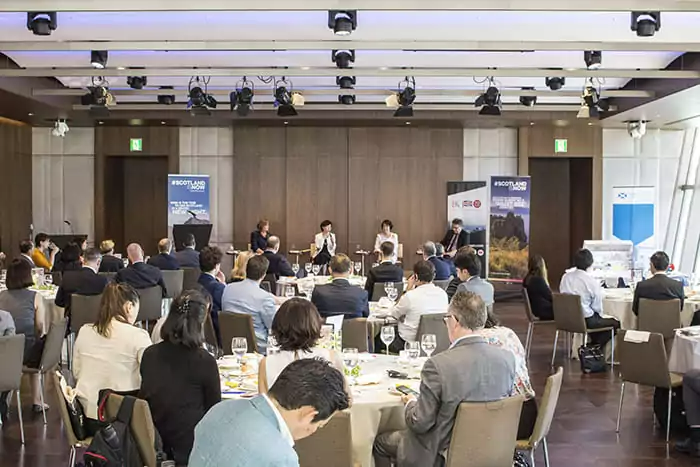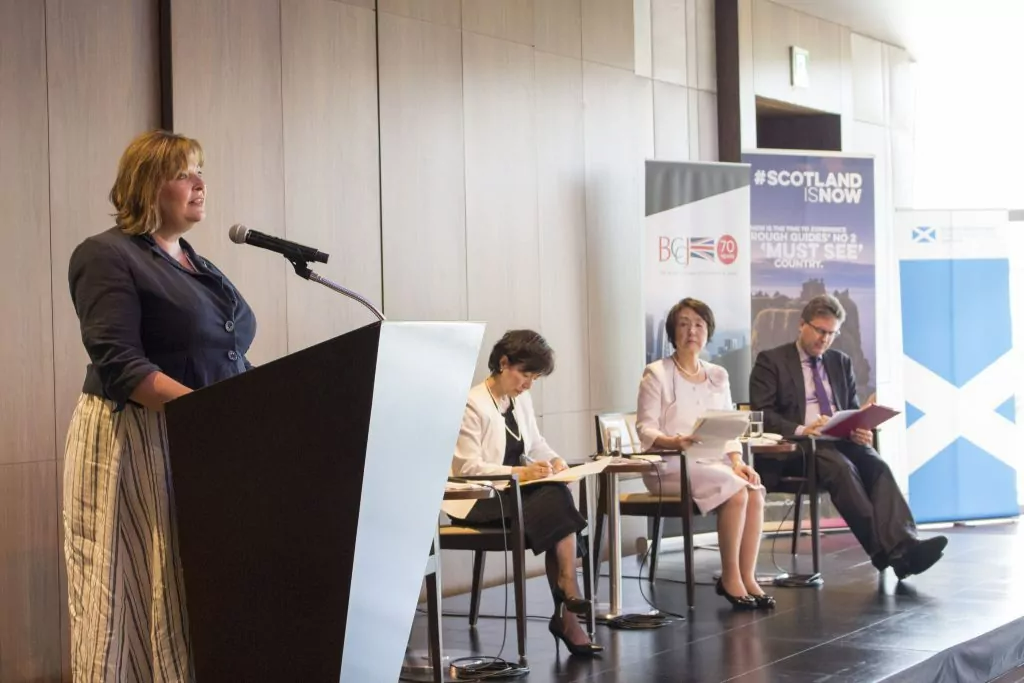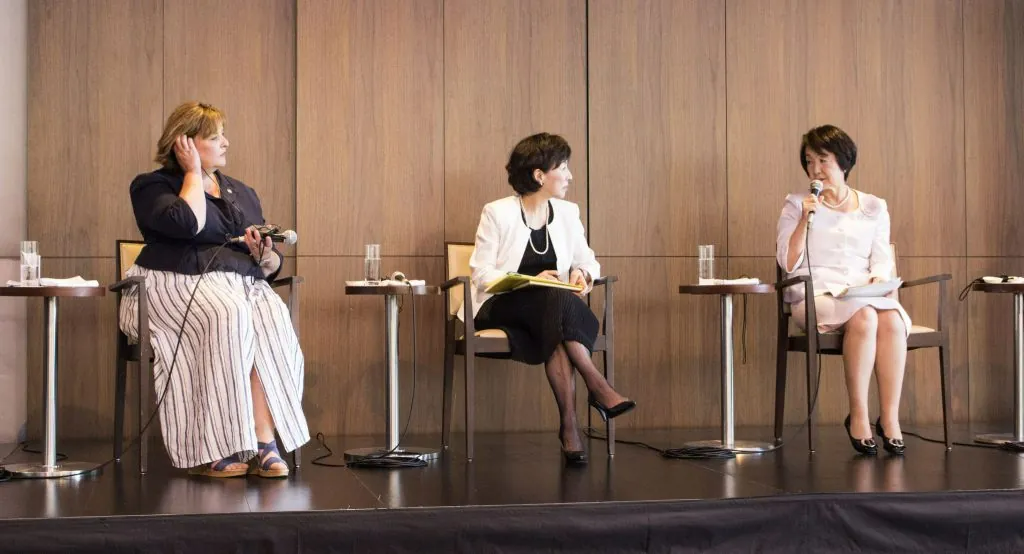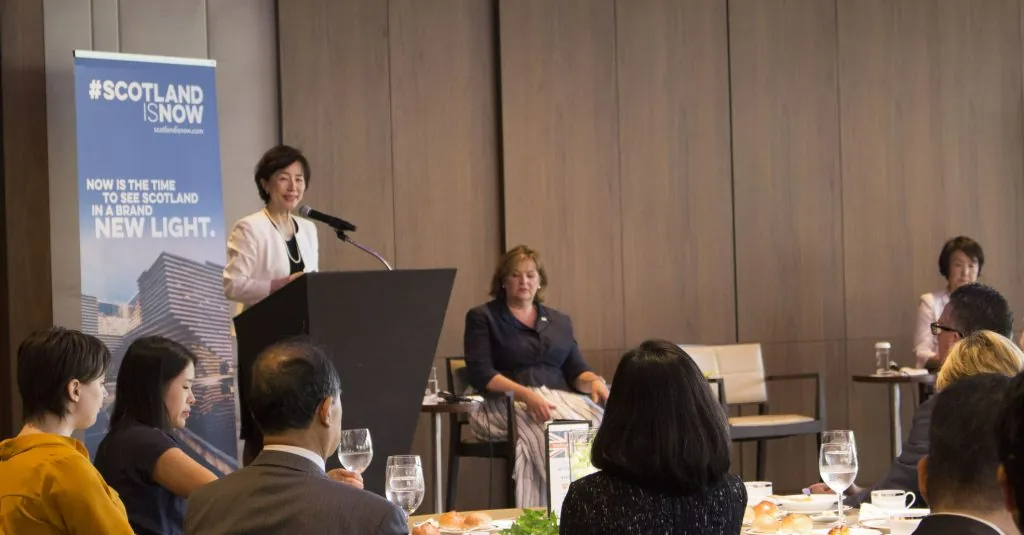Japan and Scotland: D&I lessons

The Scottish and Japanese governments share a solution to the ageing population in their respective countries: boost the participation of their working age citizens through diversity and inclusion (D&I), to drive sustainable economic growth. And corporations in both countries have lauded the potential of D&I to spark creativity, innovation, productivity and, ultimately, business success.
Yet, implementation of D&I initiatives has been slow, and the results mixed.
The BCCJ invited representatives of three D&I success stories to speak to members on 3rd July at its luncheon, “21st Century Solutions: D&I in 2018.” The speakers were Mayor of Yokohama Fumiko Hayashi, whose policies eliminated nursery waiting lists in the city; Kaori Sasaki, founder of the International Conference for Women in Business, Japan’s largest women’s conference; and Fiona Hyslop, Cabinet Secretary for Culture, Tourism and External Affairs in the Scottish government, which enjoys a 50:50 gender-balanced cabinet.
Scotland

Opening her address by affirming the Scottish government’s commitment to D&I for the country’s economic growth, Hyslop said its gender-balanced cabinet made Scotland one of few governments in the world where all its ministers are appointed according to merit. She explained that the Scottish government has embedded inclusivity in its approach, because it has been proved that businesses which have done so have a competitive edge.
“The economies of Japan and Scotland will continue to go from strength to strength if every person, regardless of background, vocation and circumstance, has the opportunity to develop the skills required to access work that offers a decent wage and job security,” she said. Participation, alongside investment, innovation and population, are key drivers of the economy, meaning women need to be supported to participate in the workforce, she added.

Measures to date from Edinburgh include the Baby Box: a box filled with baby goods that also doubles as a cot, in a bid to tackle inequality while supporting wellbeing for mother and baby. And, by the end of 2018, the government is set to double the length of time at nursery schools for three- and four-year-old children. The hours equate roughly to 9am to 3pm and are free to all.
Meanwhile, a narrowing of the country’s gender pay gap (for full-time employees) has been achieved, the gap having fallen from 18.4% in fiscal 1997 to 6.6% in fiscal 2017, but Hyslop says the existence of a gap is “unacceptable in a modern Scotland.” Measures to tackle the gap include creating a working group on the issue, promoting understanding of issues that women face in the workplace, and changing mindsets via political leadership.
Fundamentally, though, she said businesses need not only to accept and value individuals’ differences but also to celebrate them. After all, it is those differences that represent the “creativity of the human spirit,” and, in that spirit, everyone’s contribution should be valued.
“If we are going to have improvements for the working population and greater understanding between generations in an ageing society, we have to avoid putting people in a box for what we think they think, or what we think they are, based on their age, gender or sexual orientation,” she said.
Yokohama

Mayor Hayashi agreed that women require only opportunity to realise their potential. Describing Japan as a “backward nation in terms of diversity,” she said Yokohama is determined to continue to develop policies to promote diversity. Indeed, many of its women-friendly policies have been so successful that they have been adopted by the Japanese government.
When she took office in 2009, Yokohama had the longest waiting list for nursery schools of any city in Japan, with more than 500 mothers in line. In response, she increased the number of nursery schools and introduced consultants trained in early education to help families find services to suit their needs. In three years, there was no waiting list for nursery schools.
Additional services available now include support for female entrepreneurs, work style reform and a working women’s network. Yokohama plans to introduce a women’s conference led by corporates and is providing incentives for SMEs that support women to take leadership roles. Training is also available for women who seek managerial positions, while role models and mentors are being encouraged. Hayashi also noted that an increasing number of women at the mayor’s office are now taking the exam for senior positions.
She said her career experiences, over the past 50 years, were her motivation to introduce these policies. Named the 36th most powerful woman in the world (the highest place achieved by a Japanese woman) by Forbes, in 2006—three years before she took office—she has applied her business approach to her role.
“When I started working at 18, women were a minority in the workforce. Almost all were assistants to men and all were expected to stop working when they married, to have children. Nevertheless, I continued working,” she said, attributing her success to her “particular perspective as a minority as well as empathy and open-mindedness. Her former roles include being president of BMW Tokyo, president of Tokyo Nissan Auto Sales and chairperson and CEO of supermarket chain Daiei.
Japan Inc.

Kaori Sasaki shared a similar story of resilience in her career, describing Japan’s adoption of diversity as slow, with a long way to go.
Japan’s equal employment law, for example, was established some 30 years ago but it hasn’t resulted in more women in management positions, she explained. Further, the seniority system at firms rewards an employee’s time served, rather than his or her productivity, which means women tend not to reach board level. Therefore, while external boards are enjoying a greater number of female members, internal boards are not.
Sasaki’s work to date has focused on repositioning D&I from a CSR initiative to a business benefit. After establishing communication consultancy UNICUL International, Inc., she founded ewoman Inc., a think tank and consultancy that provides marketing, branding and product development for major corporations.
Like the Scottish government’s Hyslop, Sasaki believes in changing hearts and minds to deliver D&I. Ewoman promotes the idea that diversity leads to innovation, by asking women to produce new products or rebrand existing ones for firms in Japan. Sasaki also introduces female executive to organisations seeking women on their external boards and provides support through online discussion groups.
“In Japanese, we rarely use [the pronoun] ‘I’ so we encourage individuals to share their thoughts through a statement starting with ‘I’. It’s a new approach for Japanese men and women but, if people can’t participate by saying ‘I think this …’, diversity won’t happen,” she said.
In October, ewoman will launch a diversity index for corporations, whereby each employee will take an online exam on their knowledge, behaviour and attitude towards D&I. With each employee tracked by a number, HR teams will be able to assess whether certain sections or staff require more training or diverse influences.
According to Sasaki, this index will reflect firms’ D&I more effectively than head counting and will show firms that they can’t simply change their definition of management-level roles simply to meet the government guideline of 9.2% of women to hold senior jobs in private firms by 2020.
Sasaki pointed out that, in her 23 years of running the annual International Conference for Women in Business, female attendees’ ambitions, spirit and attitude have not faltered. They remain “willing to work hard to climb the corporate ladder and to support each other. All they need,” she said, “is the opportunity to do so.”
